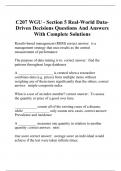Exam (elaborations)
Solutions for Classical and Modern Numerical Analysis, 1st Edition by Ackleh (All Chapters included)
- Course
- Institution
Complete Solutions Manual for Classical and Modern Numerical Analysis, 1st Edition by Azmy S. Ackleh; Edward James Allen; R. Baker Kearfott; Padmanabhan Seshaiyer ; ISBN13: 9781420091571....(Full Chapters included)...1.Mathematical Review and Computer Arithmetic 2.Numerical Solution of Nonlinear E...
[Show more]












